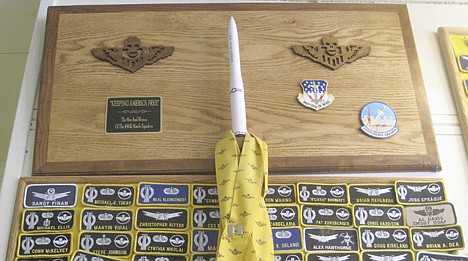Nuke heartland anxious about missile cuts
Matt Volz | Hagadone News Network | UPDATED 15 years, 8 months AGO
JUDITH GAP, Mont. - Here in America's nuclear heartland, where underground missile silos dot the landscape, a proposed U.S.-Russia treaty to reduce nuclear weapons is nothing short of alarming.
The military workers who maintain those missiles support cities as large as Great Falls, where 40 percent of the economy depends upon Malmstrom Air Force Base, and businesses as small as the Judith Gap Mercantile, where passing airmen buy milkshakes by the dozen. If they follow the missiles out of town, the economies here could be crippled.
The fate of the 450 intercontinental ballistic missiles around Malmstrom, F.E. Warren Air Force Base near Cheyenne, Wyo., and Minot Air Force Base in North Dakota is not yet clear, but politicians and community leaders are ready to fight to keep them. Even if it means not cutting nuclear weapons.
"I would keep Malmstrom at full strength, regardless," Great Falls Mayor Michael Winters said. "Each and every facet of our economy has something to do with Malmstrom."
Montana, North Dakota and Wyoming business leaders over the past year have lobbied their congressional delegations, all the while avoiding arguments about whose base is more important, said Dale Steenbergen, president and CEO of the Greater Cheyenne Chamber of Commerce.
Instead, they are trying to persuade Congress to keep the ICBM silos at full strength, arguing that they are relatively cheap to maintain and are more secure compared to bombers and submarines that also carry nuclear weapons.
"You can sink a sub or shoot down a plane. That's very different from attacking American soil, and that's what you'd have to do (to get to the ICBM silos)," Steenbergen said.
The proposed treaty would require the U.S. and Russia to reduce their nuclear warheads over the next seven years by 30 percent, to 1,550 from a previous maximum of 2,200. But it doesn't say where those cuts would come.
That's expected to be detailed in the Defense Department's Nuclear Posture Review, a comprehensive strategic review of the U.S. nuclear force. The review could be released as early as next week, Pentagon spokesman Cmdr. Bob Mehal said.
Officials at the Air Force Global Strike Command, which oversees the nation's nuclear equipped bombers and intercontinental ballistic missiles, declined to comment.
President Obama and Russian President Dmitry Medvedev are expected to sign the treaty Thursday in Prague. It must then be ratified by two-thirds of the Senate, where opponents are directing their lobbying.
Sen. Max Baucus, a Montana Democrat, said he is inclined to support ratification and that the reduction of nuclear warheads is an admirable goal. ICBMs like those at Malmstrom are likely to be spared deep cuts because they are cost-effective and could eventually be converted to carry conventional warheads, he said.
"I see no change in American force structure in the foreseeable future," Baucus said.
Malmstrom's 341st Missile Wing employs about 4,000 military personnel and civilians to manage its 150 ICBMs. One maintenance duty is to extend the life of aging Minuteman III missiles - the last of which were produced in 1978 - and the Air Force has committed nearly $6.2 billion to such life-extension programs, according to Malmstrom's Web site.
Quantifying the economic contribution of the three bases on their surrounding communities is difficult, but their importance to those cities and towns is clear.
The bases employ thousands, provide contract work for local businesses and base personnel spend money and pay taxes to the towns. There also is the fierce pride of each community being at the center of the nation's defense.
Airmen who service and maintain the missiles pass daily through Judith Gap, a town of about 150 in the center of Montana. Residents are used to regular emergency drills that involve lines of Humvees, helicopters overhead and soldiers crouched on hillsides, rifles at the ready. Their advice to a visitor: Don't stop at the silos to test the security.
The Judith Gap Mercantile, which boasts that its milkshakes are famous worldwide, takes pride in serving the military men and women who make up an estimated 70 percent of its business. A shrine is dedicated to them. Models of missiles, plaques of appreciation and shoulder patches from various military units cover a wall.
"They like to play a little game with us," said Jancy Kowalski, who makes the milkshakes. "They'll come in and say, 'We need 15 milkshakes,' and we've got like 10 minutes to close. They love to do that to us."
Neither Kowalski nor the few customers in the store Tuesday ventured a guess what losing the military trade would do, but longtime resident Andrew Arneson said it would devastate a farming and ranching community already hurt by recession.
"You'll find more people going out of business, selling their farms. They can't take it. Everything's going downhill," he said.
One city that has suffered from nuclear arms reductions is Grand Forks, N.D., which lost its 150 ICBMs to Malmstrom in a 1995 Base Realignment and Closure round.
City Councilman Eliot Glassheim said the city hired lobbyists and spent hundreds of thousands of dollars to fight the closure, but to no avail. More than 2,000 people left in the years that followed, and the city fell from second to third in the state in population and economy, Glassheim said.
Grand Forks Air Force Base has a new mission supporting unmanned aerial vehicles, but the city has diversified its economy so that it's not as reliant upon the military.
Steenbergen said he believes the three states can maintain their nuclear manpower and number of operating silos - which can house more than one missile - but may see fewer missiles because of the cuts.
"I think anytime you're going through this process there's reason to be concerned, but we don't want to cry wolf," Steenbergen said. "I know some folks are getting nervous, but I think they're leaping to some conclusions."
ARTICLES BY MATT VOLZ
Author Krakauer denied records on rape case against player
HELENA — Author Jon Krakauer’s five-year quest to find out how and why Montana’s top higher education official intervened to prevent a star college quarterback’s expulsion over a rape accusation stalled Wednesday when the state Supreme Court denied him access to those records.
Montana State Auditor Matt Rosendale announces US House run
HELENA — Montana Republicans’ 2020 election lineup shuffled again Monday after U.S. Rep. Greg Gianforte decided to run for governor instead of re-election, with State Auditor Matt Rosendale jumping into the now-open House race seven months after failing to unseat U.S. Sen. Jon Tester.
Krakauer: Court ruling on privacy hurts right to know
HELENA — Author Jon Krakauer said he feels “a moral obligation” to fight a recent court ruling against him as he tries to obtain records detailing how the expulsion of a University of Montana quarterback over a rape allegation was overturned.



